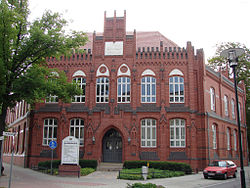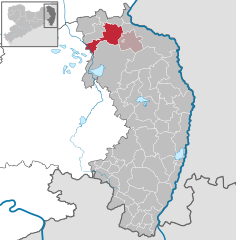|
Weißwasser
Weißwasser (Upper Sorbian: Běła Woda, pronounced [ˈbʲɪwa ˈwɔda]) is a town in Upper Lusatia in eastern Saxony, Germany. Weißwasser is the third largest town in the Görlitz district after Görlitz and Zittau. The town's landmark is its water tower. The town is part of the recognized Sorbian settlement area in Saxony. Upper Sorbian has an official status next to German, all villages bear names in both languages. HistoryWeißwasser was mentioned for the first time on 8 June 1552, when it was part of the Lands of the Bohemian Crown in the Holy Roman Empire. The town's name means "white water". In 1635 it passed to the Electorate of Saxony, and following the Napoleonic Wars, in 1815 it fell to the Kingdom of Prussia and was included within the Province of Silesia. In the 19th and 20th centuries, Weißwasser was the European centre of glass production. It became part of the Prussian Province of Lower Silesia in 1919.  Weißwasser received its town charter on 28 August 1935. During World War II, the Nazis established and operated the FAL Weisswasser subcamp of the Gross-Rosen concentration camp, whose prisoners were mainly Jewish women.[3] In the Second World War, 40% of the town was destroyed. With the dissolution of Prussia resulting from the war, the town became part of Saxony from 1945–52. It was then part of communist East Germany from 1952–90 and administered within Bezirk Cottbus. Many enterprises had to close during the communist regime. After the fall of the Berlin Wall, only a few enterprises were left. It was included within a restored Saxony after German reunification. Weißwasser now struggles with the after-effects of German reunification, as the fall of the Berlin Wall has had a devastating effect on the local economy. Many people have since lost their jobs and the town's population continues to suffers from a high percentage of unemployment. Consequently, many have left the area in the hope of finding a new job elsewhere in a reunited Germany.[citation needed] In September 2005, Weißwasser hosted the "Tag der Sachsen." The event was a success with more than 300,000 visitors, which left some believing that the town could reinvent itself as a tourist attraction.[citation needed]  There are bilingual street signs in German and Upper Sorbian in the town. Coat of armsThe coat of arms was allotted on 31 January 1927. The two green glasses symbolise the glass industry of the town, which was one of the largest in former East Germany. The tools are a reference to coal mining, which is carried out close to the city. Blue and yellow are the traditional colours of Upper Lusatia and the white waves in the bottom part of the coat of arms symbolise the name of the city. Population developmentDevelopment of the population figure since 31 December 1960
Source from 1998 on: Statistics office Saxony Politics A new city council was elected on the 13 June 2004. Out of 18,653 eligible voters, 29.36% participated in the vote. The results were as following: Twin citiesSights
SportThe local ice hockey club Dynamo Weißwasser, known presently as Lausitzer Füchse and also known as "The Foxes", was the most successful club in the ice hockey Premier League of former East Germany, winning 25 championships. Notable people
References
External linksWikimedia Commons has media related to Weißwasser. |
||||||||||||||||||||||||||||||||||||||||||||||||||||||||||||||||||||||||||||||||||||||||||||||||||||||||||||||||||||||||||||||||||||||





